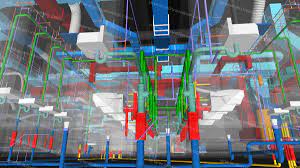In the dynamic world of modern architecture, sustainability has transcended being a mere buzzword to becoming a core ethos driving design and construction. At the heart of sustainable building design lie Mechanical, Electrical, and Plumbing (MEP) engineers, tasked with crafting efficient and eco-conscious systems. Let's explore the pivotal role of MEP services in creating sustainable structures and the strategies employed to achieve this goal.
Embracing Energy Efficiency
Energy consumption in buildings remains a significant contributor to carbon emissions. MEP engineers play a crucial role in mitigating this impact by optimizing systems for energy efficiency. Cutting-edge HVAC technologies, such as variable refrigerant flow (VRF) systems and geothermal heat pumps, offer substantial energy savings while ensuring occupant comfort. Moreover, smart controls and automation enable precise management of energy usage, adapting to occupancy patterns and environmental conditions in real-time.
Harnessing Renewable Energy Sources
Incorporating renewable energy sources into MEP systems is a cornerstone of sustainable building design. Solar photovoltaic (PV) panels, wind turbines, and geothermal heat pumps offer clean and abundant energy alternatives, reducing reliance on fossil fuels and lowering carbon emissions. MEP engineers collaborate with architects to seamlessly integrate these technologies into building designs, optimizing their placement and performance for maximum efficiency. By harnessing the power of renewables, buildings can achieve greater energy independence and contribute positively to the transition to a low-carbon future.
Prioritizing Passive Design Strategies
In addition to active MEP systems, passive design strategies play a vital role in sustainable building design. Passive solar design, natural ventilation, and daylighting techniques leverage the inherent properties of the building site and environment to minimize energy consumption and enhance occupant comfort. MEP engineers work closely with architects to integrate passive strategies into building designs, optimizing orientation, shading, and thermal mass to capitalize on natural resources and minimize reliance on mechanical systems. By prioritizing passive design, buildings can achieve significant energy savings and create more resilient and sustainable built environments.
Embracing Innovation in MEP Technologies
The field of MEP engineering is continuously evolving, with new technologies and innovations driving progress towards sustainability. From advanced HVAC systems with variable refrigerant flow to cutting-edge building automation and control systems, MEP engineers leverage the latest developments to optimize building performance and energy efficiency. Additionally, emerging technologies such as 3D printing for plumbing fixtures and sensors for real-time monitoring offer unprecedented opportunities for enhancing sustainability in MEP design. By embracing innovation, MEP Services can stay at the forefront of sustainable building design, pushing the boundaries of what is possible in creating environmentally responsible structures.
Integrating Resilience and Adaptability
MEP engineers design systems that can withstand and respond to changing environmental conditions, ensuring uninterrupted functionality and occupant safety.
Resource Conservation Strategies
Water scarcity and waste are pressing global concerns, emphasizing the need for resource-conscious design. MEP engineers integrate water-saving fixtures, rainwater harvesting systems, and greywater recycling technologies to minimize water consumption and reduce strain on local water sources. Additionally, sustainable material choices, such as recyclable piping and energy-efficient lighting fixtures, contribute to the overall eco-friendliness of the building while maintaining performance standards.
Enhancing Indoor Environmental Quality Occupant health and well-being are paramount considerations in sustainable building design. MEP systems are engineered to optimize indoor air quality through effective ventilation and filtration mechanisms. Advanced air quality monitoring sensors detect pollutants and adjust ventilation rates accordingly, ensuring a healthy indoor environment. Furthermore, thoughtful lighting design harnesses natural daylight and employs energy-efficient fixtures to create visually comfortable spaces conducive to productivity and well-being.
The Power of Integrated Design
Achieving optimal performance in MEP systems necessitates a collaborative and integrated approach to design and construction. Early engagement of MEP engineers facilitates seamless integration with architectural and structural elements, maximizing space utilization and efficiency. Performance modeling tools enable predictive analysis, allowing designers to fine-tune MEP systems for optimal performance throughout the building's lifecycle. Moreover, commissioning and ongoing monitoring ensure that systems operate at peak efficiency post-construction, delivering lasting sustainability benefits.
Conclusion
Optimizing MEP services is instrumental in the quest for sustainable building design. By prioritizing energy efficiency, resource conservation, and indoor environmental quality, MEP engineers play a pivotal role in creating eco-conscious structures that prioritize both planet and people. Through innovative technologies, integrated design approaches, and a commitment to excellence, the built environment can become a powerful ally in the fight against climate change. Together, we can build a greener, more sustainable future for generations to come.


No comments yet